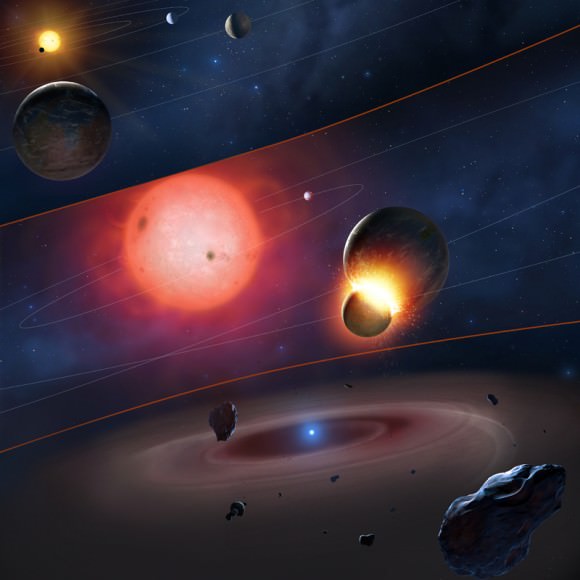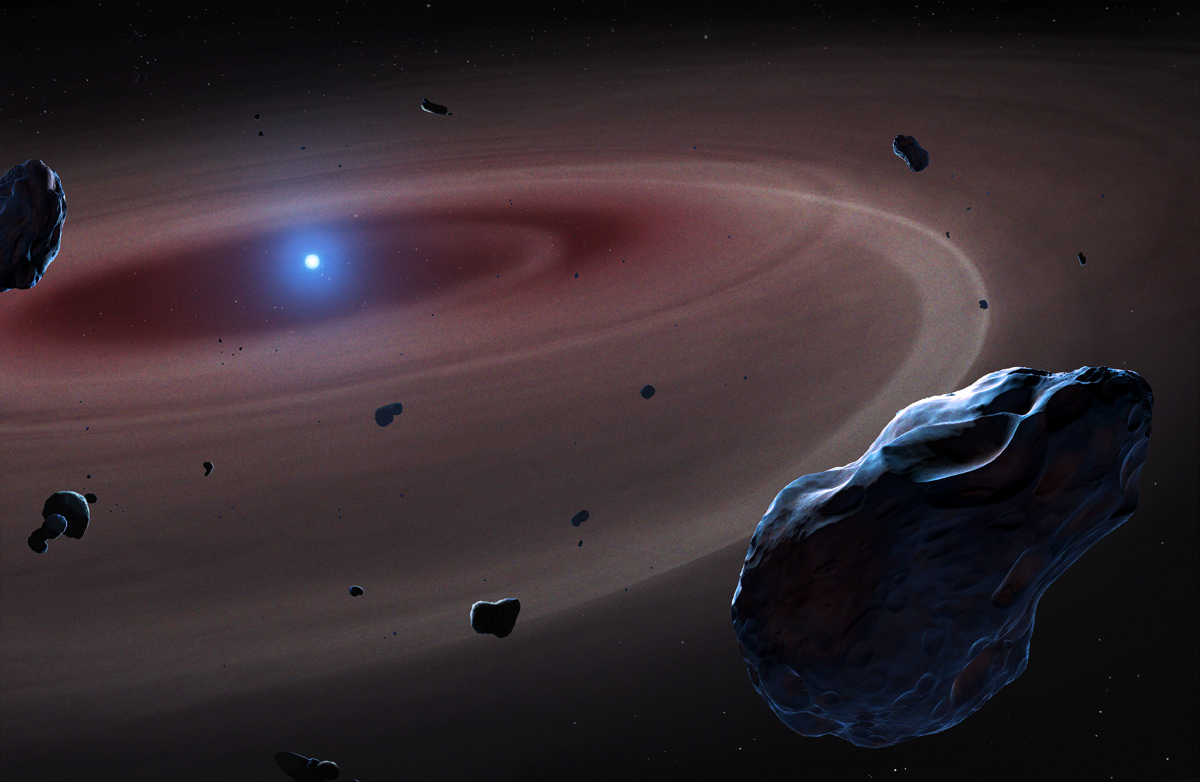[/caption]
Astronomers have found four nearby white dwarf stars surrounded by disks of material that could be the remains of rocky planets much like Earth — and one star in particular appears to be in the act of swallowing up what’s left of an Earthlike planet’s core.
The research, announced today by the Royal Astronomical Society, gives a chilling look at the eventual fate that may await our own planet.
Astronomers from the University of Warwick used Hubble to identify the composition of four white dwarfs’ atmospheres, found during a survey of over 80 such stars located within 100 light-years of the Sun. What they found was a majority of the material was composed of elements found in our own Solar System: oxygen, magnesium, silicon and iron. Together these elements make up 93% of our planet.
In addition, a curiously low ratio of carbon was identified, indicating that rocky planets were at one time in orbit around the stars.
Since white dwarfs are the leftover cores of stellar-mass stars that have burnt through all their fuel, the material in their atmosphere is likely the leftover bits of planets. Once held in safe, stable orbits, when their stars neared the ends of their lives they expanded, possibly engulfing the innermost planets and disrupting the orbits of others, triggering a runaway collision effect that eventually shattered them all, forming an orbiting cloud of debris.
This could very well be what happens to our Solar System in four or five billion years.
“What we are seeing today in these white dwarfs several hundred light years away could well be a snapshot of the very distant future of the Earth,” said Professor Boris Gänsicke of the Department of Physics at the University of Warwick, who led the study. “During the transformation of the Sun into a white dwarf, it will lose a large amount of mass, and all the planets will move further out. This may destabilise the orbits and lead to collisions between planetary bodies as happened in the unstable early days of our solar systems.”

One of the white dwarfs studied, labeled PG0843+516, may even be actively eating the remains of an once-Earthlike world’s core.
The researchers identified an abundance of heavier elements like iron, nickel and sulphur in the atmosphere surrounding PG0843+516. These elements are found in the cores of terrestrial planets, having sunk into their interiors during the early stages of planetary formation. Finding them out in the open attests to the destruction of a rocky world like ours.
Of course, being heavier elements, they will be the first to be accreted by their star.
“It is entirely feasible that in PG0843+516 we see the accretion of such fragments made from the core material of what was once a terrestrial exoplanet,” Prof. Gänsicke said.
It’s an eerie look into a distant future, when Earth and the inner planets could become just some elements in a cloud.
Read the full story on the RAS site here.


Stellar wobbles and occultations
Now we can add a 3rd way to find (former) planetary siblings.
Still leaves me with two questions though, how did the material survive so long in a Stellar Orbit during the Red Giant phase, and what caused the orbit collapse during the white dwarf phase.
The way I read it is this:
– the left over bits and pieces are the remnants of planets that were not so close as to be engulfed by the red giant
– the destabilization of the orbits was a result of the star losing mass which made it a white dwarf.
Regards.
We’re talking about ages of 20-200M years. Considering the current assumed time needed to form a planetary system, I would rather say: something is missing.
1) Debris remnants around more white dwarfs. Ones with (sub)stable orbits
2) Debris would have to travel at least ~1-2 AU inward from any orbit within 20-200M years, AFTER the central point of Gravity lost weight …. !
If you assume Jupiter’s Orbit will stay about the same, (for ease) anything with an inner orbit would be flung out or in or stabilize within a few 1000 years. Mind you, Jupiter not only has an 11 year orbit, but any inner orbit will be influenced by Jupiter more often! Example every ~2 years for mars or 500 orbits per 1000 years.
And we’re talking 20-200M years for the 4 white dwarfs here.
When red giants become white dwarfs, they blow off the outer layers of their atmospheres to form a planetary nebula (which is probably one of the most beautiful structures produced in nature at any scale). I would imagine that the nebula could generate sufficient drag to cause orbital decay of planets that survived the giant phase. This could lead to collisions if planets wander too close to each other, which would allow the dwarf to swallow the shattered remains piece by piece, or it could just send planets careening directly into the white dwarf.
like Francisco responded I didn’t know that a mother able to profit $8707 in 4 weeks on the internet. have you seen this page ===>> http://starjob.blogspot.in/
In other words, a cloud of dust and debris. Pretty much what existed at the onset of a solar system. Dust and debris that eventually generated planetisimals and coalesced even further to planets. Maybe we’re just watching an intermediary phase. The next step is the formation of new planets?
Maybe it’s all a big cycle, like everything else in nature.
It would have to be a much longer cycle than you are thinking if we have to wait for the solar mass to regain its nuclear fuel to sustain another cycle of habitable planets. Perhaps the collapse and rebirth of the universe.
Pulsars have been found to have planets. These probably formed after the supernova violence that ended the active star. So it is not unreasonable to suspect that rocky planets might reform in an orbit around a white dwarf. Of course they will be cold and barren. Also Jupiter and the gas giants in our solar system will persist during the white dwarf phase of the sun for a long time.
LC
“…when their stars neared the ends of their lives they expanded. ” Those shock front(s) and expanding solar wind may have driven off the carbon after vaporizing it into dust? There might be a very tenuous and expanding cloud of carbon soot detectable?
White Dwarfs are composed largely of carbon, since the kinds of stars that leave white dwarf remnants transition from primarily fusing hydrogen into helium to primarily fusing helium into carbon as they enter the giant phase that precedes the white dwarf phase. This can actually be directly observed within a red giant, it’s called a “carbon flash” because it coincides with a burst of radiation as much larger energies are suddenly released. Therefore, a low carbon ratio in a white dwarf merely points to impurities in the remnant’s atmosphere, not an especially carbon-poor planet per se. However, if our solar system is a reasonable guide (and it very well might not be), terrestrial planets tend to be very poor in carbon, so if that holds true across other systems, it’s rather unlikely that we could detect a carbon cloud, since it would be such a tiny fraction of the planet’s mass. It is possible that roughly earth-mass planets would be very carbon-rich (it would require the planet to form from a stellar nebula that is unusually enriched in carbon) but since a white dwarf is composed mostly of carbon to begin with, it would be very difficult to detect any impurity that such a planet might introduce to the white dwarf’s atmosphere.
as Sean implied I am dazzled that a student able to make $9187 in one month on the computer. did you look at this site ===>> http://seekwork2home.blogspot.com/